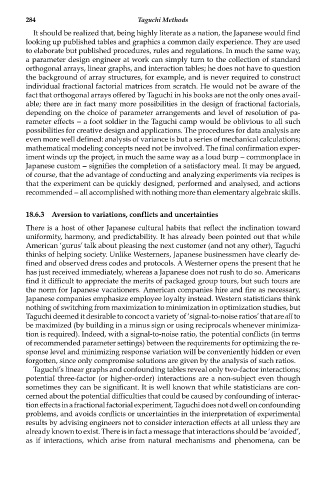Page 299 - Six Sigma Advanced Tools for Black Belts and Master Black Belts
P. 299
OTE/SPH
OTE/SPH
August 31, 2006
JWBK119-18
Taguchi Methods
284 3:6 Char Count= 0
It should be realized that, being highly literate as a nation, the Japanese would find
looking up published tables and graphics a common daily experience. They are used
to elaborate but published procedures, rules and regulations. In much the same way,
a parameter design engineer at work can simply turn to the collection of standard
orthogonal arrays, linear graphs, and interaction tables; he does not have to question
the background of array structures, for example, and is never required to construct
individual fractional factorial matrices from scratch. He would not be aware of the
fact that orthogonal arrays offered by Taguchi in his books are not the only ones avail-
able; there are in fact many more possibilities in the design of fractional factorials,
depending on the choice of parameter arrangements and level of resolution of pa-
rameter effects -- a foot soldier in the Taguchi camp would be oblivious to all such
possibilities for creative design and applications. The procedures for data analysis are
even more well defined: analysis of variance is but a series of mechanical calculations;
mathematical modeling concepts need not be involved. The final confirmation exper-
iment winds up the project, in much the same way as a loud burp -- commonplace in
Japanese custom -- signifies the completion of a satisfactory meal. It may be argued,
of course, that the advantage of conducting and analyzing experiments via recipes is
that the experiment can be quickly designed, performed and analysed, and actions
recommended -- all accomplished with nothing more than elementary algebraic skills.
18.6.3 Aversion to variations, conflicts and uncertainties
There is a host of other Japanese cultural habits that reflect the inclination toward
uniformity, harmony, and predictability. It has already been pointed out that while
American ‘gurus’ talk about pleasing the next customer (and not any other), Taguchi
thinks of helping society. Unlike Westerners, Japanese businessmen have clearly de-
fined and observed dress codes and protocols. A Westerner opens the present that he
has just received immediately, whereas a Japanese does not rush to do so. Americans
find it difficult to appreciate the merits of packaged group tours, but such tours are
the norm for Japanese vacationers. American companies hire and fire as necessary,
Japanese companies emphasize employee loyalty instead. Western statisticians think
nothing of switching from maximization to minimization in optimization studies, but
Taguchi deemed it desirable to concoct a variety of ‘signal-to-noise ratios’that are all to
be maximized (by building in a minus sign or using reciprocals whenever minimiza-
tion is required). Indeed, with a signal-to-noise ratio, the potential conflicts (in terms
of recommended parameter settings) between the requirements for optimizing the re-
sponse level and minimizing response variation will be conveniently hidden or even
forgotten, since only compromise solutions are given by the analysis of such ratios.
Taguchi’s linear graphs and confounding tables reveal only two-factor interactions;
potential three-factor (or higher-order) interactions are a non-subject even though
sometimes they can be significant. It is well known that while statisticians are con-
cerned about the potential difficulties that could be caused by confounding of interac-
tion effects in a fractional factorial experiment, Taguchi does not dwell on confounding
problems, and avoids conflicts or uncertainties in the interpretation of experimental
results by advising engineers not to consider interaction effects at all unless they are
already known to exist. There is in fact a message that interactions should be ‘avoided’,
as if interactions, which arise from natural mechanisms and phenomena, can be

